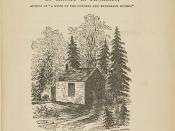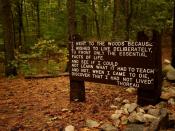The idea of romanticism was created as a way of combating the rationalist and formalist ideas of 18th century Europe. Also, it can be said that the roots of romanticism first took foot at the end of the French Revolution. People were unhappy with the popular philosophies of life at the time and they felt like they needed something new. They thought that there was more to life and nature than the physical and tangible beauty of things. The philosophy of romanticism was more focused upon the emotions and feelings of people. Also, the French Revolution changed the way people thought about how to go about social change. They began to favor a more natural, progressive method to change rather than the swift and bloody revolutions that began in France. This can all be seen through the music, poetry, and other arts of the philosophy.
Romantic ideals can be seen very well in poetic form through the words of a Scottish poet, Robert Burns.
He was born in a rural village and idealized nature and the rustic rural life. He wrote to a field mouse which he had found while plowing a field, "Wee, sleekit, cow'rin, tim'rous beastie." This shows that he both admires the natural "beastie" in the mouse, but he still calls it small and scared. Henry David Thoreau's writings at Walden Pond are perfect examples of the glorification of nature in romanticism. He wrote while living alone in a small shack near a pond in New England. He completely surrounded himself with nature and that was all that his writing reflected. Wolfgang von Goethe was a romantic writer who lived in Germany. He searched for happiness and wisdom his entire life, and created many great works in the progress.
Many painters caught the romantic spirit.



Father of Romanticism
I think that the article is well developed and contained all its sides BUT a great fact is missing. The auther of this article forgot to state when historicians and critics officially consider the beginning of the Romanticism movement. This was with William Wordworth's and Samuel Coleridge's publication of their "Lyrical Ballads".
2 out of 2 people found this comment useful.